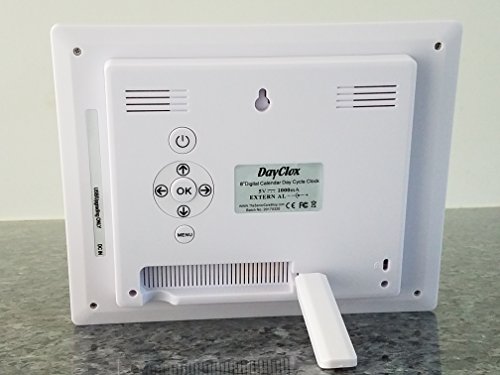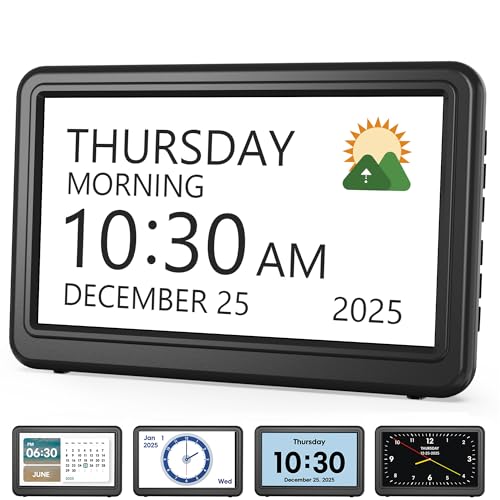The Best Memory Loss Clock

To help you find the perfect memory loss clock, we continuously put forth the effort to update and expand our list of recommendable memory loss clocks. Our team collects, edits and publishes new information, in order to present it to you in an accurate, significant and neatly arranged way.
Our Picks
8 More Memory Loss Clock Alternatives
Table of Contents
Buying Guide
Memory Loss Clocks – Keeping you Aware
The clock is utilized by individuals each day. It helps remind us of when to arise for the day, helps us plan our daily schedule, helps us meet deadlines and remember important tasks, and is a personal assistant we never knew we had. Above all, clocks were created to assist us. The memory loss clock was specifically designed for individuals who struggle to keep up with the time. Whether it be an important reminder of the day of the week or the specific day in time, these clocks display more than just the time. They are designed to display the day, time, and date. These displays often carry big block letters that pop out at the consumer. They often harness a black background with white lettering placed on top or vice versa. This helps the distinguishing factors for those who may suffer from Alzheimer's or dementia. Beyond that, these clocks contain a multitude of uses that we'll discuss further later. Below one will find a comprehensive product list that displays the different memory loss clocks on the market today. Beyond our product list, we'll detail the importance of these devices and develop a buying guide for potential users.
Memory Loss Clocks Product List:
Memory Loss Clock Buying Guide
As one can see from the displayed results, there is little to distinguish these clocks from one another on a 'look' basis. These models all contain similar first-glance exteriors, utilizing the black background with white lettering across the screen. The borders are a little different for each, with the white on black border suiting individuals who struggle from depth perception problems or other such visual imparities. The price range seems to fall within the same run for most of these models. Anywhere from $40-$50 seems to be the standard, creating a tough choice for consumers when it comes to selecting the correct model for usage. Distinguishing these models from one another relies heavily on the individual features these products hold. Below we'll dive into these features and discuss what they mean for you.
Powering Mechanisms
One universal difference seems to be the different battery or wall powering methods. These clocks will hold battery power, utilize a wall or AC adapter, or feature a solar powered element. There is a slight difference between these methods. The battery powered method relies solely on the power of a watch battery or something that produces similar output. This is a universal battery that can be used to power other devices, making scarcity of this component a non-issue for the consumer. Battery powered models will run months to years at a time before running out. These battery replacements can cost anywhere from $5-$10, so having a backup battery at the ready is something to consider with this power format. The cost of battery power relates almost directly to that of a wall adapter or AC adapter in that it will be similar in yearly pricing to power.
The wall or AC adapter models come with their own individual hook-ups. Once again, these hook-ups do not vary much in nature or make-up, allowing the consumer replacement options no matter the model. The chord that comes with the output should stretch around 6 to 10 feet. Anything less should draw a concern because it will limit the area of usage. The cost equates to a minor charge on your monthly electric bill.
The third powering format is the use of solar energy. These models are powered by solar rays and will not carry an additional replacement cost due to their internal nature. This is the most cost-effective option in the memory loss clock space. These models may carry a premium of $5-$10 apiece, but will pay for themselves over the cost of replacement batteries or electric charges. The only concern with these models is lack of solar energy. This lack of energy can be directly associated to the display of the content on your clock. Be wary of this powering format if you cannot provide the solar energy these devices need to perform at a high level.
As the powering formats relate to individuals who suffer from Alzheimer's or dementia, it is good practice to go with the wall or AC adapter powering models. These models won't cause for a complexion in battery removal or the lack of power from solar energy. They are reliable in the sense that they will always keep your model powered, barring a power outage. This creates less of a task for these individuals and reduces the need for fixing or additional tasks.
Specific Features
Each of these models holds intrigue when it comes to the additional features they offer. These features should be noted and handled on a need basis. For example, someone who suffers from dementia is not going to need a model that has endless formatting and adjustment features. They are going to want the straight forward model that lists only the necessary content.
One important feature to host is the use of an alarm clock. These clocks can be programmed to host important dates and times to ensure you aren't forgetting about a particular event or date. The models that allow you to set these alarms with pin point accuracy are the obvious choice. It allows you to set-up events and dates months or years ahead of time, creating a personal reminder that is both accurate and helpful. These features are enjoyed by people who suffer from memory loss or busy individuals alike. It creates a personal assistant for the business-minded individual and a constant reminder for those who have trouble remembering.
A second feature is the use of time of day display mechanisms. These mechanisms help people who suffer from sleep problems and other such time allocation problems. Displaying times like morning, afternoon, and evening help create association measures that are beneficial to those who struggle with this. This feature is not offered with all models, so assessing your personal need for this setting will directly influence the buying process.
Some models will offer extended display elements. Items like temperature, moon calendar, and extended measures help create additional recognition items. People will sometimes enjoy tracking the full moon schedule and having a device that displays that for you can keep this tracking on schedule. The temperature display helps individuals associate when it is a good day to remain indoors due to heat or frigid conditions. These additional measures provide you with an added look at the current day and can provide additional support in some circumstances.
Additional Uses
Beyond the uses for individuals struggling with memory components or the busy business-minded individual, these clocks make for a great learning tool. Teaching younger individuals how to tell time is something that isn't taken lightly. Displaying these numbers and names in large, bold writing can directly influence this learning curve. They display the full name for each day of the week, which can help younger individuals learn how to spell. The days of the week are often complex terms when it comes to the learning brain, providing an opportunity for individuals to challenge their learning potential.
They also make great tools for the dimly lit room. They provide LED displays that give the listed characters an added sense of recognition. The white on black scheme allows these characters to pop out at the user. They can help increase visual acuity in areas where it can often be lacking.
The uses span beyond the few described, making it a very versatile personal reminder. Assessing your personal usage will help you in the decision making process.
Top Rated Memory Loss Clocks
If you're looking into finding the best rated memory loss clock, you should probable check out the American Lifetime New 2026 Dementia Clock. We looked at various sources of reviews and found this one to have the best mix between review count and average rating stars.
The Lowest Price We Could Find
Often, going for the best price is a simple but good option. With a price of $24.99 (last checked this morning), we do not list any other memory loss clock cheaper than the Golony Digital Alarm Clock. Just remember that it's not always the best option to go for the cheapest one.
The Memory Loss Clock With the Most Reviews
With at least 5544 reviews and counting, the American Lifetime New 2026 Dementia Clock might be another option to consider. This large amount of reviews signalizes that many people are using it, with most of them beeing satisfied.
High Quality Memory Loss Clocks
It's quite rare that the saying "You get what you pay for" turns out incorrect. If you have the money on the sideline, feel free to choose the most expensive item from our list: The American Lifetime New 2026 Dementia Clock currently sells for $59.95.
The Memory Loss Clock With the Most Clicks
If you trust us and our users, feel free to check out the American Lifetime New 2026 Dementia Clock. Our statistics say that it is the most favorite Memory Loss Clock from the list above.
Our Bestseller
If you're still undecided, I would recommend that you go with the masses and choose the top selling memory loss clock: The Wuhan Wismco E-commerce Co., Ltd. Clock is the hottest bestseller in this category right now.
Memory Loss Clock Reviews
Further Reading on Memory Loss Clocks
Comments
About this Article
It was last updated on 2026-01-04 08:11:01 and has been viewed 5581 times.


